#infrared wavelengths
Explore tagged Tumblr posts
Text
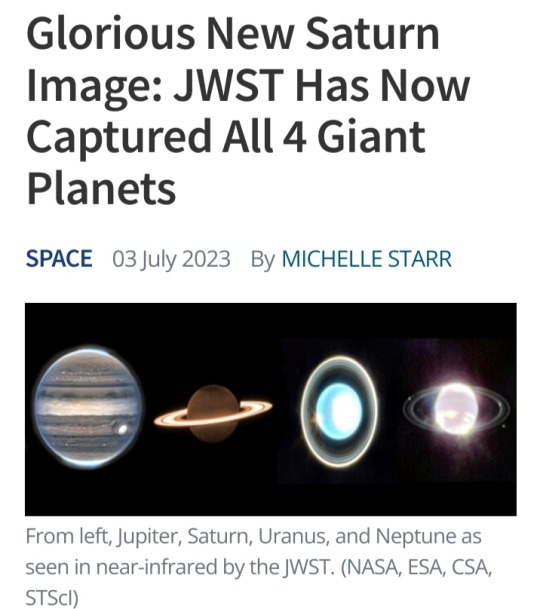
With the addition of Saturn, the James Webb Space Telescope has finally captured all four of our Solar System's giant worlds.
JWST's observations of the ringed planet, taken on 25 June 2023, have been cleaned up and processed, giving us a spectacular view of Saturn's glorious rings, shining golden in the darkness.
By contrast, the disk of Saturn is quite dark in the new image, lacking its characteristic bands of cloud, appearing a relatively featureless dim brown.
This is because of the wavelengths in which JWST sees the Universe – near- and mid-infrared.
These wavelengths of light are usually invisible to the naked human eye, but they can reveal a lot.
For example, thermal emission – associated with heat – is dominated by infrared wavelengths.
When you're trying to learn about what's going on inside a planet wrapped in thick, opaque clouds, studying its temperature is a valuable way to go about it.
Some elements and chemical processes emit infrared light, too. Seeing the planets of the Solar System in wavelengths outside the narrow range admitted by our vision can tell us a lot more about what they have going on.
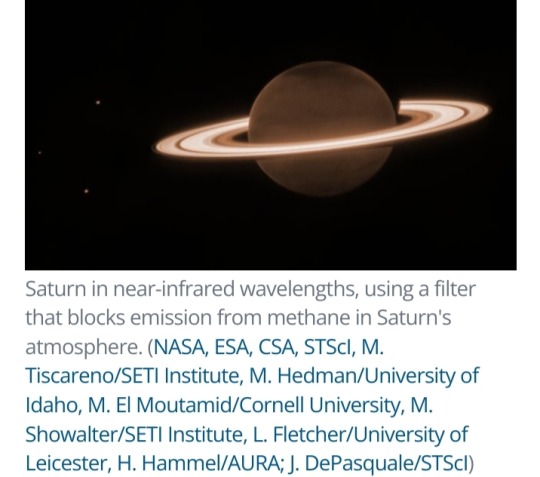
Saturn
As we saw last week, when we clapped eyes on the raw JWST Saturn images, the observations involved filters that dimmed the light of the planet, while allowing light from the rings and moons to shine brightly.
This is so a team led by planetary scientist Leigh Fletcher of the University of Leicester in the UK can study the rings and moons of Saturn in more detail.
They hope to identify new ring structures and, potentially, even new moons orbiting the gas giant.
The image above shows three of Saturn's moons, Dione, Enceladus and Tethys, to the left of the planet.
Although dim, the disk of the planet also reveals information about Saturn's seasonal changes.
The northern hemisphere is reaching the end of its 7-year summer, but the polar region is dark. An unknown aerosol process could be responsible.
Meanwhile, the atmosphere around the edges of the disk appears bright, which could be the result of methane fluorescence, or the glow of trihydrogen, or both. Further analysis could tell us which.

Jupiter
Jupiter was the first of the giant planets to get the JWST treatment, with images dropping in August of last year – and boy howdy were they stunning.
The spectacular detail seen in the planet's turbulent clouds and storms was perhaps not entirely surprising.
However, we also got treated to some rarely seen features: the permanent aurorae that shimmer at Jupiter's poles, invisible in optical wavelengths, and Jupiter's tenuous rings.
We also saw two of the planet's smaller, lesser-known moons, Amalthea and Adrastea, with fuzzy blobs of distant galaxies in the background.
"This one image sums up the science of our Jupiter system program, which studies the dynamics and chemistry of Jupiter itself, its rings, and its satellite system," said astronomer Thierry Fouchet of Paris Observatory in France, who co-led the observations.
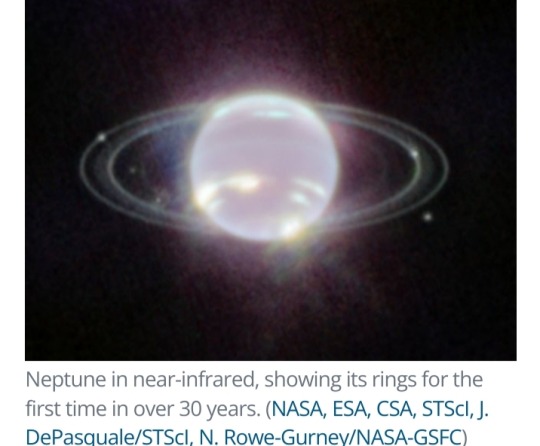
Neptune
Observations of Neptune arrived in the latter half of September 2022.
Because Neptune is so very far away, it tends to get a little neglected; you're probably used to seeing, if anything, the images taken by Voyager 2 when it flew past in 1989.
JWST's observations gave us, for the first time in more than 30 years, a new look at the ice giant's dainty rings – and the first ever in infrared.
It also revealed seven of Neptune's 14 known moons, and bright spots in its atmosphere.
Most of those are storm activity, but if you look closely, you'll see a bright band circling the planet's equator.
This had never been seen before and could be, scientists say, a signature of Neptune's global atmospheric circulation.
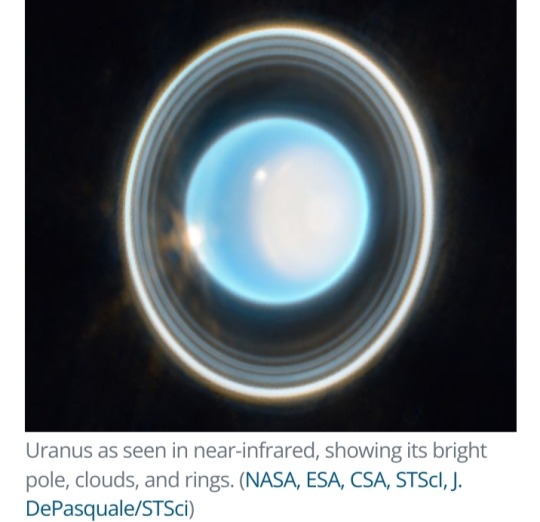
Uranus
Uranus is also pretty far away, but it's also a huge weirdo. Although very similar to Neptune, the two planets are slightly different hues, which is something of a mystery.
Uranus is also tipped sideways, which is challenging to explain too.
JWST's observations, released in April 2023, aren't solving these conundrums.
However, they have revealed 11 of the 13 structures of the incredible Uranian ring system and an unexplained atmospheric brightening over the planet's polar cap.
JWST has a lot to say about the early Universe; but it's opening up space science close to home, too.
As its first year of operations comes to an end, we can't help but speculate what new wonders will be to come in the years ahead.

Top: Jupiter - Neptune / Bottom: Uranus - Saturn
Credit: NASA
#James Webb Space Telescope#Solar System#Saturn#Jupiter#Uranus#Neptune#planets#space#universe#infrared wavelengths#wavelengths#JWST#Leigh Fletcher#planetary science#Thierry Fouchet#moons#Voyager 2#giant planets#astronomy
1K notes
·
View notes
Text
Striking new Webb image showing alignment of bipolar jets confirms star formation theories
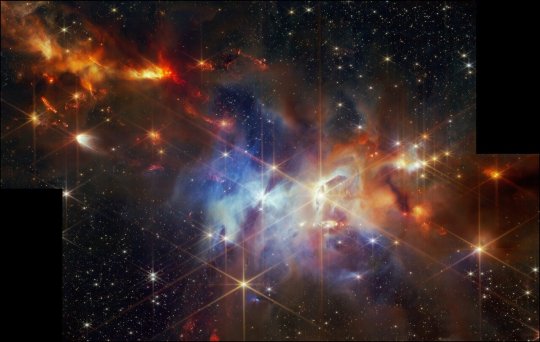
(Credit: NASA, ESA, CSA, STScI, K. Pontoppidan (NASA's Jet Propulsion Laboratory), J. Green (Space Telescope Science Institute))
"For the first time, a phenomenon astronomers have long hoped to image directly has been captured by the NASA/ESA/CSA James Webb Space Telescope's Near-InfraRed Camera (NIRCam). In this stunning image of the Serpens Nebula, the discovery lies in the northern area of this young, nearby star-forming region.
The astronomers found an intriguing group of protostellar outflows, formed when jets of gas spewing from newborn stars collide with nearby gas and dust at high speeds. Typically, these objects have a variety of orientations within one region. Here, however, they are all slanted in the same direction, to the same degree, like sleet pouring down during a storm."
"So, just how does the alignment of the stellar jets relate to the rotation of the star? As an interstellar gas cloud collapses in on itself to form a star, it spins more rapidly. The only way for the gas to continue moving inward is for some of the spin (known as angular momentum) to be removed.
A disk of material forms around the young star to transport material down, like a whirlpool around a drain. The swirling magnetic fields in the inner disk launch some of the material into twin jets that shoot outward in opposite directions, perpendicular to the disk of material."
continue reading
#astronomy#universe#space#james webb space telescope#jwst#wavelengths#infrared#bipolar#stars#planets#visible spectrum#invisible spectrum#light#color#rotation#spinning#magnetic field#magnetism#plasma physics
25 notes
·
View notes
Text
Figure 20.3 summarises the wavelengths and frequencies of some regions of the electromagnetic spectrum. (...) The infrared region of the electromagnetic spectrum (figure 20.3) covers the range of wavelengths from 7.8 × 10-⁷ m (just longer than the visible than the visible region) to 2.0 × 10-³ m (just shorter than the microwave region).
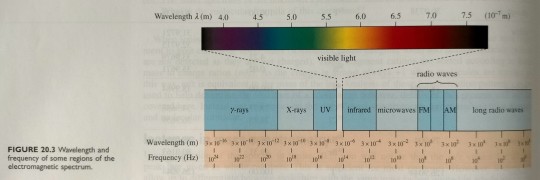
"Chemistry" 2e - Blackman, A., Bottle, S., Schmid, S., Mocerino, M., Wille, U.
#book quotes#chemistry#nonfiction#textbook#wavelength#electromagnetic spectrum#gamma rays#x rays#ultraviolet light#uv light#visible light#infrared light#microwaves#radio waves#fm radio#am radio#long radio waves#frequency
2 notes
·
View notes
Text

The Science Research Cahiers of S. Sunkavally, p 522.
#chlorophyll#absorbed wavelengths#winter#wave number#double bonds#ultraviolet absorption#background microwave radiation#infrared radiation#potassium bromide#transparency#ultraviolet light#opacity of ice to X-rays#gamma radiation#hair#ion-exchange resin#fur#panting#shedding of heat#satyendra sunkavally#theoretical biology#watering hole#osmotic stress#erythrocyte#collagen#brain#emotional control#deuterium oxide
0 notes
Text
850nm vs 940nm IR LED Wavelengths - Which is best for a Night Vision Camera?
If you are interested in night vision devices, you may have come across the dilemma, 850nm vs 940nm. These are the wavelengths of infrared (IR) light that are commonly used to enhance the visibility of objects in the dark. But what are the differences between these two wavelengths, and how do they affect the performance of your night vision device? In this blog post, we will explain the…
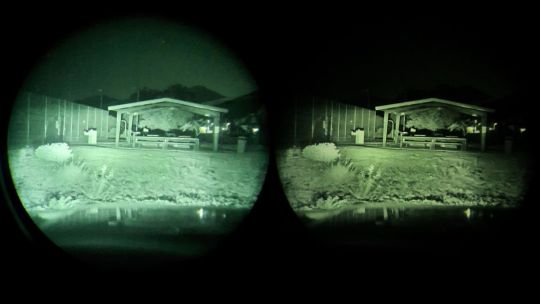
View On WordPress
0 notes
Text
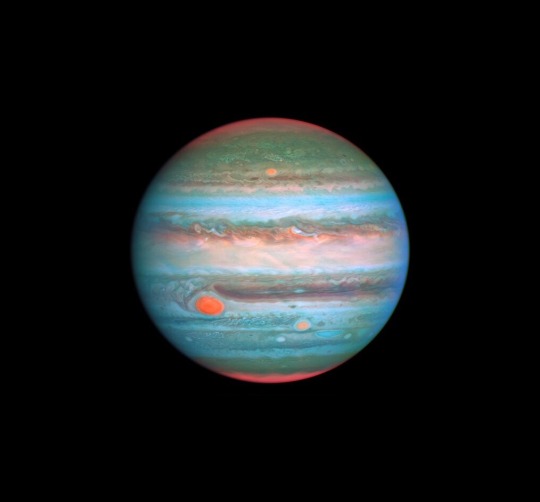
Jupiter in infrared and ultraviolet wavelengths. Astronomers use these filters (and others not shown here) to study differences in cloud thickness, altitude, and chemical makeup.
Credit: NASA/ESA
2K notes
·
View notes
Text

Love Letters from Space
Love is in the air, and it’s out in space too! The universe is full of amazing chemistry, cosmic couples held together by gravitational attraction, and stars pulsing like beating hearts.
Celestial objects send out messages we can detect if we know how to listen for them. Our upcoming Nancy Grace Roman Space Telescope will help us scour the skies for all kinds of star-crossed signals.

Celestial Conversation Hearts
Communication is key for any relationship – including our relationship with space. Different telescopes are tuned to pick up different messages from across the universe, and combining them helps us learn even more. Roman is designed to see some visible light – the type of light our eyes can see, featured in the photo above from a ground-based telescope – in addition to longer wavelengths, called infrared. That will help us peer through clouds of dust and across immense stretches of space.
Other telescopes can see different types of light, and some detectors can even help us study cosmic rays, ghostly neutrinos, and ripples in space called gravitational waves.
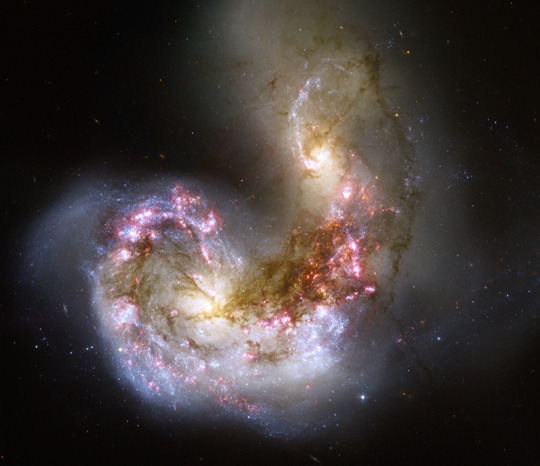
Intergalactic Hugs
This visible and near-infrared image from the Hubble Space Telescope captures two hearts locked in a cosmic embrace. Known as the Antennae Galaxies, this pair’s love burns bright. The two spiral galaxies are merging together, igniting the birth of brand new baby stars.
Stellar nurseries are often very dusty places, which can make it hard to tell what’s going on. But since Roman can peer through dust, it will help us see stars in their infancy. And Roman’s large view of space coupled with its sharp, deep imaging will help us study how galaxy mergers have evolved since the early universe.
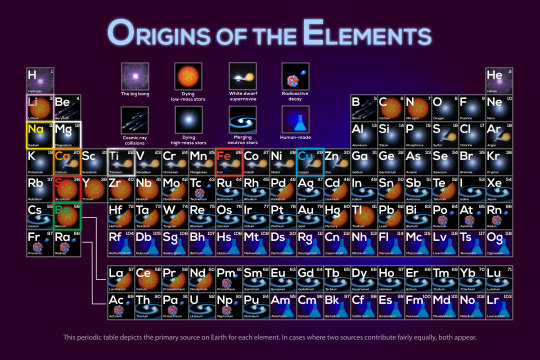
Cosmic Chemistry
Those stars are destined to create new chemistry, forging elements and scattering them into space as they live, die, and merge together. Roman will help us understand the cosmic era when stars first began forming. The mission will help scientists learn more about how elements were created and distributed throughout galaxies.
Did you know that U and I (uranium and iodine) were both made from merging neutron stars? Speaking of which…
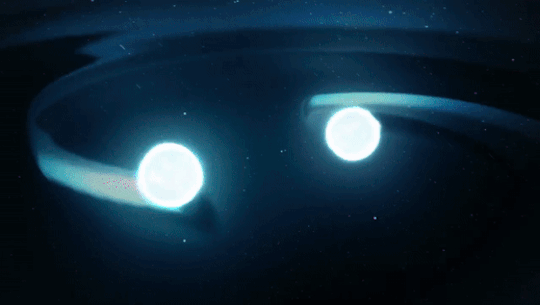
Fatal Attraction
When two neutron stars come together in a marriage of sorts, it creates some spectacular fireworks! While they start out as stellar sweethearts, these and some other types of cosmic couples are fated for devastating breakups.
When a white dwarf – the leftover core from a Sun-like star that ran out of fuel – steals material from its companion, it can throw everything off balance and lead to a cataclysmic explosion. Studying these outbursts, called type Ia supernovae, led to the discovery that the expansion of the universe is speeding up. Roman will scan the skies for these exploding stars to help us figure out what’s causing the expansion to accelerate – a mystery known as dark energy.
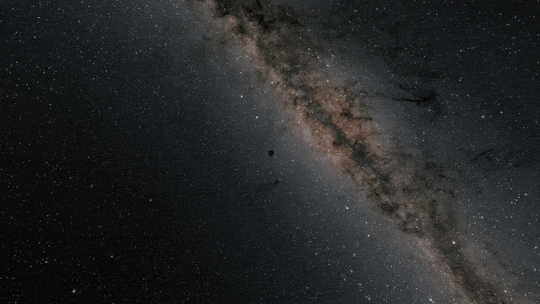
Going Solo
Plenty of things in our galaxy are single, including hundreds of millions of stellar-mass black holes and trillions of “rogue” planets. These objects are effectively invisible – dark objects lost in the inky void of space – but Roman will see them thanks to wrinkles in space-time.
Anything with mass warps the fabric of space-time. So when an intervening object nearly aligns with a background star from our vantage point, light from the star curves as it travels through the warped space-time around the nearer object. The object acts like a natural lens, focusing and amplifying the background star’s light.
Thanks to this observational effect, which makes stars appear to temporarily pulse brighter, Roman will reveal all kinds of things we’d never be able to see otherwise.
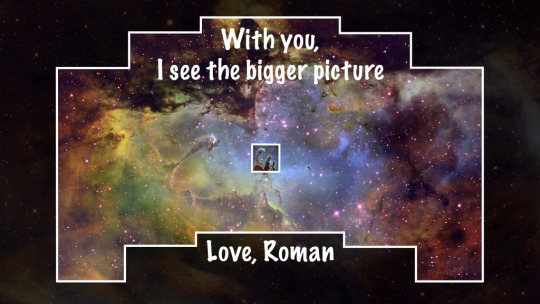
Roman is nearly ready to set its sights on so many celestial spectacles. Follow along with the mission’s build progress in this interactive virtual tour of the observatory, and check out these space-themed Valentine’s Day cards.
Make sure to follow us on Tumblr for your regular dose of space!
#NASA#astronomy#telescope#Roman Space Telescope#Valentine’s Day#space#science#STEM#nebula#chemistry#galaxies#black holes#rogue planets#exoplanets#Hubble Space Telescope#tech
2K notes
·
View notes
Text

NGC 2566 (MIRI image)
The galaxy filling the frame in this NASA/ESA/CSA James Webb Space Telescope Picture of the Month is NGC 2566, a spiral galaxy located in the constellation Puppis. In this image Webb’s Mid-InfraRed Instrument (MIRI) puts the thick clouds of interstellar dust that suffuse NGC 2566 on display, as well as the galaxy’s compact, bright core.
At 76 million light-years away, NGC 2566 is considered a nearby galaxy, making it an excellent target for studying fine details like star clusters and gas clouds. The new Webb images of NGC 2566 were collected as part of an observing programme (#3707) dedicated to understanding the connections between stars, gas and dust in nearby star-forming galaxies. NGC 2566 is just one of the 55 galaxies in the local Universe examined by Webb for this programme.
To gain a full understanding of the star-formation process in nearby galaxies, astronomers will combine Webb data with observations from other telescopes. At the long-wavelength end of the electromagnetic spectrum, the 66 radio dishes of the Atacama Large Millimeter/submillimeter Array (ALMA) provide a detailed view of the cold, turbulent clouds where stars are born. The NASA/ESA Hubble Space Telescope has also cast its gaze on NGC 2566, and a new Hubble image of this galaxy was released earlier this week. The Hubble data will help researchers take a census of the stars in nearby galaxies, especially the young stars that are bright at the ultraviolet and visible wavelengths to which Hubble is sensitive. Together, the Webb, Hubble and ALMA data provide a rich view of the cold gas, warm dust and brilliant stars in NGC 2566.
The Webb data are part of a Treasury programme, which means that the data may help answer multiple important questions about our Universe. Treasury data are available for use by scientists and the public without a waiting period, amplifying the scientific impact and allowing exploration to begin immediately.
[Image Description: A spiral galaxy, seen close-up. Its core is a round spot that glows intensely bright, crowned by eight long and spikes that extend across the galaxy, artefacts of the telescope’s structure. Its disc is an oval shape with edges made of very thick and cloudy arms of gas and dust, mostly blue but paler and brighter around patches of stars. Wisps of darker dust also fill the inner disc and swirl off the ends of the arms.]
Credits: ESA/Webb, NASA & CSA, A. Leroy;
154 notes
·
View notes
Note
Hey! Weird request, but do you have prompts for how science and maths could be used in magic scenarios to gain the upper hand and make a battle much easier? So far all I have is using infrared glasses to see an invisible warrior
Science and Math in Magical Battle Scenarios
-> feel free to edit and adjust as you see fit.
Angles of reflection can amplify protective spells. You can design a series of intricate mirrors arranged in a geometric pattern to reflect and amplify your magical shields against an incoming attack.
A sound dampening cloak that absorbs sound waves, making the wearer nearly silent. Using principles of acoustics, the cloak allows the user to sneak up on opponents or escape unnoticed, enhancing stealth tactics during combat.
Sound Waves as Weapons. Combining musical abilities with sound frequency analysis, you can use math to calculate the exact frequency that can disrupt an enemy's concentration or shatter magical barriers, crafting a powerful song that acts as both a weapon and a shield.
A handheld device that scans the environment for various wavelengths of light, allowing the user to see through illusions, detect hidden magical traps, or analyze the composition of materials around them.
Calculating Gravity's Pull. Using physics to modify gravity around a battlefield. By calculating gravitational pull with equations, you can create zones where enemies feel heavy and sluggish, while allies feel lighter and faster, turning the tide of battle.
Using chemistry to concoct volatile mixtures that create spectacular distractions or devastating explosions. By carefully measuring ingredients and employing magical runes, you can cause reactions to target specific enemy units.
Employing concepts from quantum mechanics to create portals that allow you to teleport around the battlefield instantly. By calculating the right coordinates based on your enemies’ positions, you can dodge attacks and reposition themselves strategically.
A small device that releases a swarm of nanobots capable of repairing injuries or armor in real-time. The nanobots can also serve offensive purposes, overwhelming an enemy or disabling their technology.
Light Manipulation. Combine the principles of optics with magic to bend light, creating illusions or cloaking yourself and your allies from view. By understanding how light refracts and reflects, you can create a battlefield advantage by confusing your enemies.
A headset that uses artificial intelligence to analyze an opponent’s movements in real-time. By processing data on their fighting style, it predicts their next moves, providing the user with tactical insights and a chance to counter effectively.
A grenade that emits a short burst of electromagnetic energy, disabling electronic devices and magical constructs in its radius. It could be used to thwart technologically enhanced enemies or disrupt their magical defenses.
#writing prompts#creative writing#writeblr#story prompt#prompt list#ask box prompts#fantasy prompts#sci fi prompt#science and math prompts#battle prompts#fantasy worldbuilding
172 notes
·
View notes
Text
HOW ARE BLACK HOLES CREATED, AND HOW DO THEY GROW??
Blog#461
Wednesday, December 11th, 2024
Welcome back,
In 2017, astronomers started finding monster black holes in the very early universe. Containing roughly a billion times the mass of our Sun, these black holes were surrounded by disks of infalling matter shining so intensely that we can detect them across immense stretches of space and time.
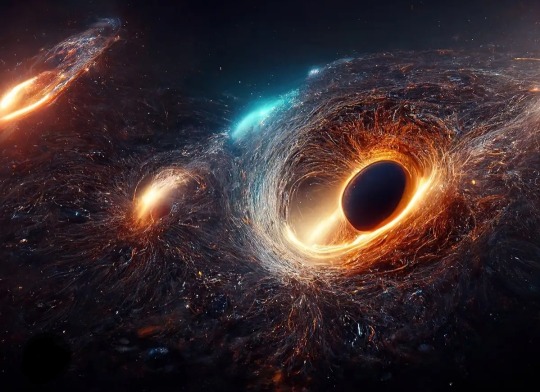
These gravitational giants existed when the universe was only 700 million years old, or 5 percent its current age. At that point in cosmic history, the universe was still a toddler. Gravity was just beginning to rein in clouds of gas and dark matter to form structures that would later evolve into mature spiral and elliptical galaxies. Stars were beginning to pop into being, but they do today.
According to the traditional picture of black hole formation and growth, the universe at this time simply had not existed long enough for black holes to bulk up to a billion solar masses.
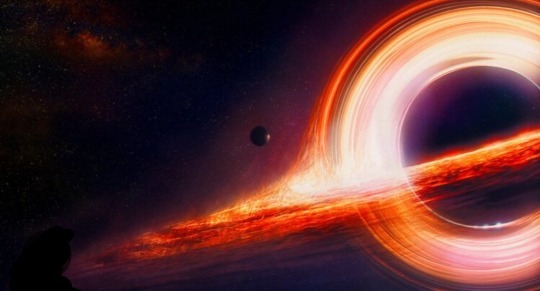
So, based on our general understanding of how black holes form and grow, these black holes should not exist.
And yet they do — posing a major challenge that astrophysicists have yet to unravel.
Quasars are brightly shining beacons of light and energy generated by the accretion of material onto supermassive black holes. In the 1990s, astronomers using a combination of ground- and space-based telescopes started to find extremely distant quasars powered by black holes of a billion or more solar masses.
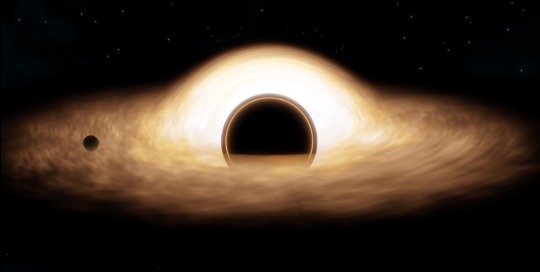
By the mid-2010s, it was no longer a big deal to find quasars dating back to 1 billion or 2 billion years after the Big Bang. But theorists had a difficult time explaining how such massive black holes could have arisen so soon in the universe’s history.
For quasars and other objects that existed many billions of years ago, it’s meaningless to express their distances in terms of light-years. The universe has expanded so much between then and now that astronomers instead refer to an object’s redshift, which is a measurement of how much cosmic expansion has stretched the object’s light toward redder (longer) wavelengths.

For years, astronomers such as the University of Arizona’s Xiaohui Fan have been identifying quasars at redshifts as high as 6, when the universe was about 900 million years old. They’ve even found a few around redshift 7, which corresponds to an era when the universe was about 735 million years old. But in late 2017, an international team led by Eduardo Bañados of the Carnegie Institution for Science announced a quasar at a record-shattering redshift of 7.54. This quasar, designated J1342+0928 (J1342 for short), based on its sky coordinates in Boötes, was radiating 40 trillion Suns’ worth of energy at a time when the universe was only 690 million years old.
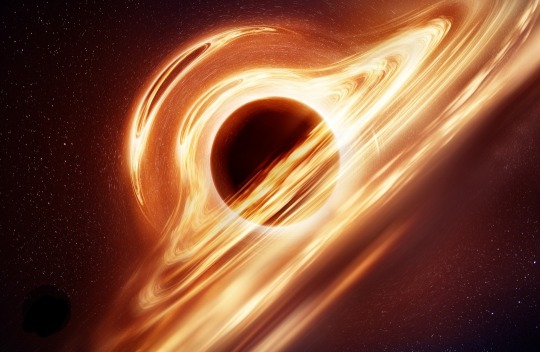
The team found J1342 by mining data from NASA’s Wide-field Infrared Survey Explorer satellite, the United Kingdom Infrared Telescope Deep Sky Survey Large Area Survey, and the DECam Legacy Survey. They used the 6.5-meter Magellan Telescope in Chile to measure the quasar’s redshift, while observations with the 8-meter Gemini North Telescope in Hawaii enabled the team to estimate the black hole’s mass: around 800 million Suns.
Originally published on https://www.astronomy.com
COMING UP!!
(Saturday, December 14th, 2024)
"HOW BIG CAN 'SUPER MASSIVE BLACK HOLES' GET??"
#astronomy#outer space#alternate universe#astrophysics#universe#spacecraft#white universe#space#parallel universe#astrophotography
82 notes
·
View notes
Photo
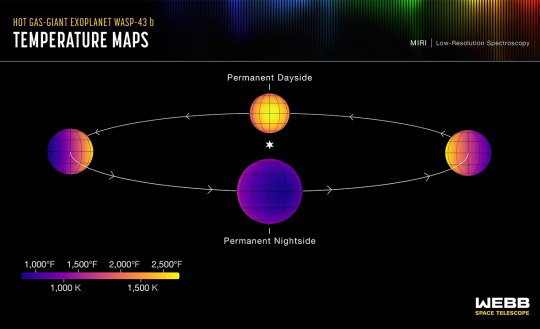
2024 May 3
Temperatures on Exoplanet WASP-43b Illustration Credit: NASA, ESA, CSA, Ralf Crawford (STScI) Science: Taylor Bell (BAERI), Joanna Barstow (The Open University), Michael Roman (University of Leicester)
Explanation: A mere 280 light-years from Earth, tidally locked, Jupiter-sized exoplanet WASP-43b orbits its parent star once every 0.8 Earth days. That puts it about 2 million kilometers (less than 1/25th the orbital distance of Mercury) from a small, cool sun. Still, on a dayside always facing its parent star, temperatures approach a torrid 2,500 degrees F as measured at infrared wavelengths by the MIRI instrument on board the James Webb Space Telescope. In this illustration of the hot exoplanet's orbit, Webb measurements also show nightside temperatures remain above 1,000 degrees F. That suggests that strong equatorial winds circulate the dayside atmospheric gases to the nightside before they can completely cool off. Exoplanet WASP-43b is now formally known as Astrolábos, and its K-type parent star has been christened Gnomon. Webb's infrared spectra indicate water vapor is present on the nightside as well as the dayside of the planet, providing information about cloud cover on Astrolábos.
∞ Source: apod.nasa.gov/apod/ap240503.html
161 notes
·
View notes
Video
Jupiter: 10 Years of OPAL Observations by NASA Hubble Space Telescope Via Flickr: Hubble's sharp images track clouds and measure the winds, storms, and vortices, in addition to monitoring the size, shape, and behavior of Jupiter's Great Red Spot (GRS) storm. Hubble follows as the GRS continues shrinking in size and its winds are speeding up. OPAL data recently measured how often mysterious dark ovals — visible only at ultraviolet wavelengths — appeared in the "polar hoods" of stratospheric haze. Unlike Earth, Jupiter is only inclined three degrees on its axis (Earth is 23.5 degrees). Seasonal changes might not be expected, except that Jupiter's distance from the Sun varies by about 5% over its 12-year-long orbit, and so OPAL closely monitors the atmosphere for seasonal effects. Another Hubble advantage is that ground-based observatories can't continuously view Jupiter for two Jupiter rotations, because that adds up to 20 hours. During that time, an observatory on the ground would have gone into daytime and Jupiter would no longer be visible until the next evening. These two views of Jupiter showcase the wealth of information provided by the spectral filters on the Hubble Space Telescope's Wide Field Camera 3 (WFC3) science instrument. At left, the RGB composite is created using three filters at wavelengths similar to the colors seen by the human eye. At right, the wavelength bounds are widened beyond the visible range to extend just into the ultraviolet (UV) and infrared regimes. Humans cannot perceive these extended wavelengths, but some animals (such as mantis shrimp, whose eyes function similarly to certain sensors on some NASA missions) are able to detect infrared and ultraviolet light. The result is a vivid disk that shows UV-absorbing lofty hazes as orange (over the poles and in three large storms, including the Great Red Spot), and freshly-formed ice as white (compact storm plumes just north of the equator). Astronomers, including the OPAL team, use these filters (and others not shown here) to study differences in cloud thickness, altitude, and chemical makeup. For more information: science.nasa.gov/missions/hubble/nasas-hubble-celebrates-... Image credit: NASA, ESA, Amy Simon (NASA-GSFC), Michael H. Wong (UC Berkeley); Image Processing: Joseph DePasquale (STScI) Find us on X, Instagram, Facebook and YouTube
#NASA#Hubble#ESA#Hubble Space Telescope#telescope#space telescope#cosmos#universe#space#cosmic#astronomy#Jupiter#flickr
54 notes
·
View notes
Text
New image from James Webb Space Telescope reveals astonishing Saturn and its rings

(Credit: NASA, ESA, CSA, STScI, Matt Tiscareno (SETI Institute), Matt Hedman (University of Idaho), Maryame El Moutamid (Cornell University), Mark Showalter (SETI Institute), Leigh Fletcher (University of Leicester), Heidi Hammel (AURA), J. DePasquale (STScI))
“Get ready to be amazed by the latest James Webb Space Telescope (JWST) image. Saturn's iconic rings seem to glow eerily in this incredible infrared picture, which also unveils unexpected features in Saturn's atmosphere.
This image serves as context for an observing program that will test the telescope's capacity to detect faint moons around the planet and its bright rings. Any newly discovered moons could help scientists put together a more complete picture of the current system of Saturn, as well as its past.
Methane gas absorbs almost all the sunlight falling on the atmosphere at this picture's specific infrared wavelength (3.23 microns). As a result, Saturn's familiar striped patterns aren't visible because the methane-rich upper atmosphere blocks our view of the primary clouds.”
continue article
#astronomy#universe#space#saturn#infrared#solar system#james webb telescope#james webb space telescope#JWST#wavelengths#visible spectrum#atmosphere#magnetic field#rotation
80 notes
·
View notes
Text
Figure 8.3 shows a plot of Mλ versus λ for different temperatures.
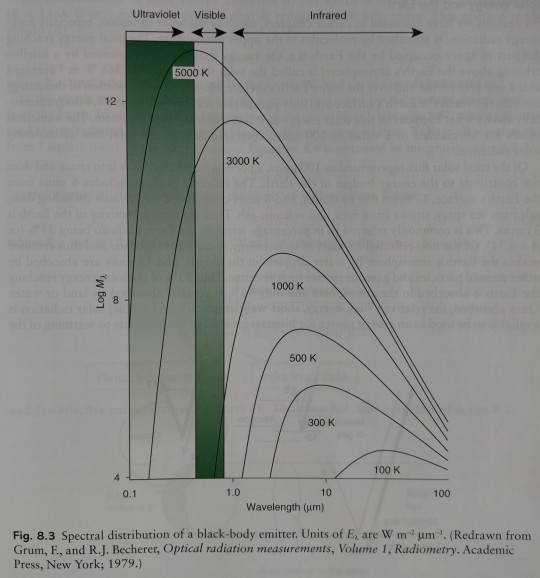
"Environmental Chemistry: A Global Perspective", 4e - Gary W. VanLoon & Stephen J. Duffy
#book quotes#environmental chemistry#nonfiction#textbook#temperature#wavelength#light#black body radiation#ultraviolet#uv light#visible light#infrared#ir light
0 notes
Text
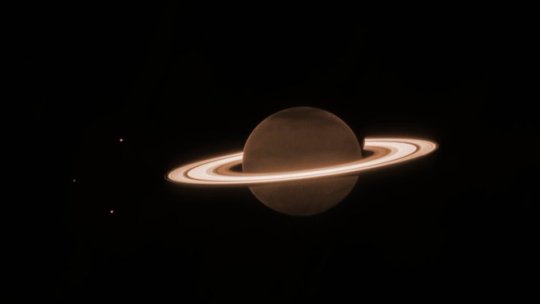
Saturn
NASA’s James Webb Space Telescope took its first near-infrared look at Saturn on June 25. The planet appears dark at this wavelength, as methane gas in its atmosphere absorbs sunlight — but its icy rings stay bright!
Of course Saturn brought its ring light 🪐
#james webb#james webb space telescope#james webb images#saturn#nasa#nasa webb telescope#nasa picture of the day#space#solar system#planet
767 notes
·
View notes
Text
GOJO'S SIX EYES because we don't talk enough about what Gojo sees... and when you really think about it, it's TOO MUCH

First off, thinking about how freaking insecure I'd be if Gojo were real and he could see me.
That man's vision is beyond 20/20 when his eyes are uncovered... Aside from seeing cursed energy in incredible detail, he can probably see very fine details and that's scary.
He can see all the flaws. LITERALLY.
There's a panel in the manga that also revealed he can see someone's soul... WHAT THE FUCK. He perceives it the same way Mahito can.
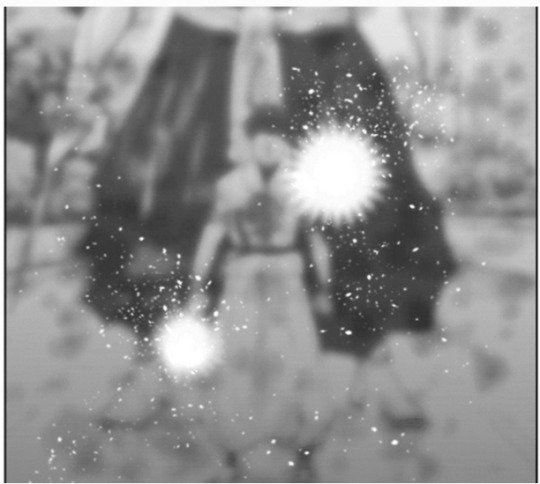
A normal human body to his uncovered eyes consists of physical and spiritual layers and he can see it.
Gege mentioned in a fan book that with the blindfold on, his vision is like a high definition thermal camera.
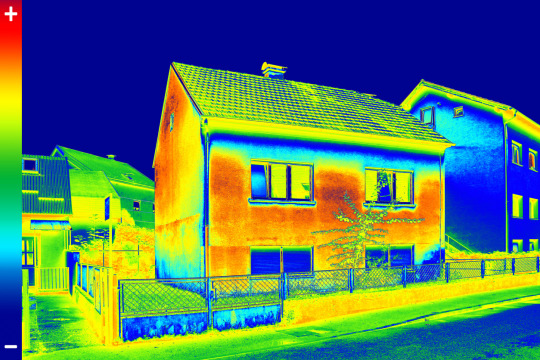
What does the world even look like to his naked eyes?
Do his eyes function like a microscope sometimes? Since, you know, manipulation of cursed energy to an atomic level and all that. And when he was a student, he passively mentioned learning how to detect poisons to essentially train his Infinity to recognize it as a threat and filter it out.
Speaking of manipulating cursed energy to an atomic level, Gojo would be great at physics, chemistry, and math. 🤷♀️
How far is his field of vision and how's the depth? Do the Six Eyes defy logic and Gojo has 340º vision? Like a bird of prey or something? Maybe not literally, but his visual perception probably is something similar to that or idk.
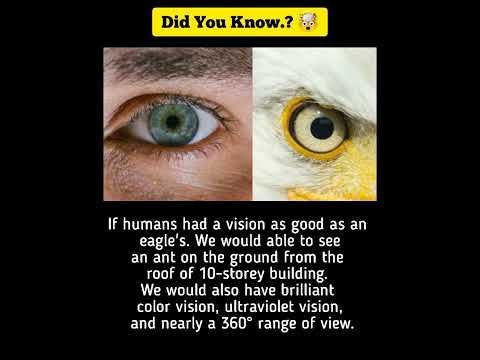
I bet he can see through his eyelids too.
Can he see through walls? It's insinuated that he can in Season 1 Episode 3, when Nobara was fighting that low Grade 3 Cursed Spirit. And he was wearing a blindfold.
Can he see other wavelengths of light? Infrared, radio, ultra-violet, X-ray, and gamma-ray?
The normal human eye interprets a limited range of light. Meaning, there are colors that normal people can't see. "Impossible colors" are a thing... And Gojo is not normal. Can Gojo SEE "IMPOSSIBLE COLORS"?
Gege... I know you hate the man, but give us a full breakdown of what the Six Eyes can SEE. I WANT TO KNOW. 😭 My imagination ain't enough.
His eyes got me on a spiral, and don't get me started on the amount of information his brain is probably processing every fucking day if his eyes are uncovered.
Also, if Megumi brings it up at some point, Gojo would DEFINITELY argue that he has better eyesight than a bald eagle. 💀
#jujutsu kaisen#jjk#gojo satoru#satoru gojo#gojou satoru#six eyes#gojo headcanons#jjk headcanons#jjk manga#jjk anime#wbad blog#wbad shit posts
198 notes
·
View notes
